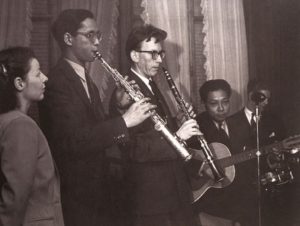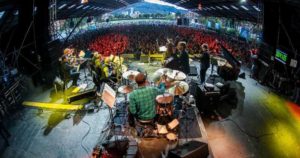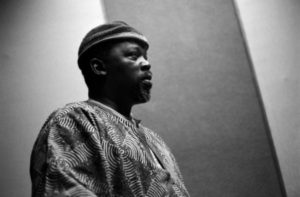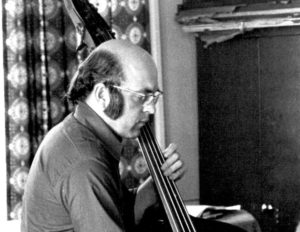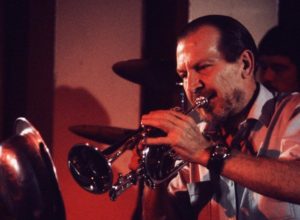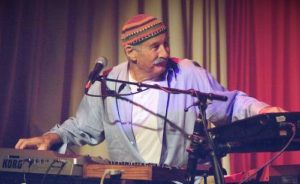Jazz in Denmark
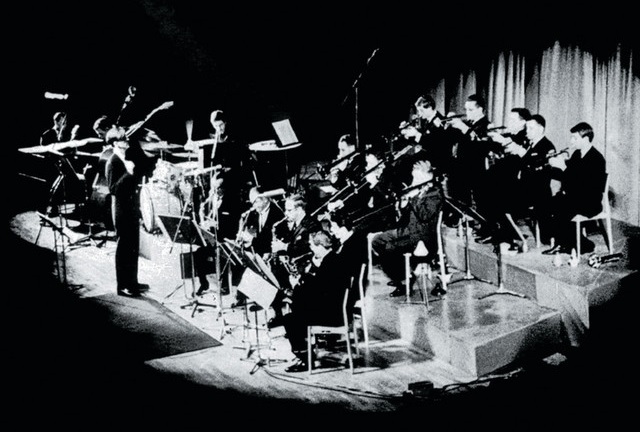
C-melody saxophonist Valdemar Eiberg (1892-1965) made the first jazz recordings with an octet in Denmark in 1924. His band included alto player Kai Ewans (1906-1988), who would go onto lead his own big band, featuring other players who would have an impact on the early Danish jazz scene, trombonist Peter Rasmussen (1906-1992) and violinist Svend Asmussen (1916-2017). Ewans recorded prolifically, including a number of sides with Benny Carter. He retired his band in 1947, moving to USA, where sixty years later his model-granddaughter Vanessa would marry Donald Trump Jr leaving us with the strange quirk that one of the 45th president’s grandchildren, Kai Trump, is named after a Danish jazz musician. Asmussen led swing groups from the late 1930s, which would showcase a technique that could match his American idols. Another interesting figure in the thirties was the quirky Fats Waller-influenced singer-pianist, Leo Mathisen (1906-1969). Also influenced by Waller, was Karen Jonsson (1906-1942), who managed squeeze a lot into her tragically short life. The singer-pianist was a popular film actress in the 1930s, composed film scores and left behind a handful of songs that have become Danish jazz standards. She was just 33 when she died of pneumonia (or possibly an overdose).
The war years, under Nazi occupation, inevitably led to jazz disappearing from public life in Denmark. After the war, throughout Europe, jazz would split into two distinct camps, those who favoured traditional New Orleans style jazz, and those that would draw inspiration from the new bebop records arriving from America. Storyville Records, which was founded in 1952 by Karl Emil Knudsen, started with reissues of 78rpm records by American artists of the 1920s, before releasing original albums by British ‘trad jazz’ artists like Ken Colyer and Chris Barber, and American blues artists recorded in Copenhagen. Among the Danish artists to record for Storyville, trombonist Papa Bue (1930-2011) and his Viking Jazz Band were prominent, remaining a popular draw into the 1990s. By the 1980s, the label branched out into straight ahead mainstream records by Denmarks’ best exponents of the style, including Jesper Thilo (born 1941) and the brothers Niels and Chris Lan Doky (pianist and bassist respectively).
During the 1950s, at the same time that Storyville were celebrating European Dixieland, the cool jazz sounds of Dave Brubeck, Lee Konitz, Lennie Tristano, Gerry Mulligan and Modern Jazz Quartet became the inspiration for a wave of talented young Danes. Baritone saxophonist Max Brüel (1927-1995) recorded some fine Mulliganesque sides in 1955, with Bent Axen (1925-2010) on piano, Erik Moseholm (1930-2012) on bass, Finn Savery (born 1933) on vibes, and trumpeter Jorgen Ryg (1927-1981) – each of whom would go on to make significant contributions to Danish jazz as bandleaders in their own right. Moseholm in particular would experiment with Third Stream jazz-classical fusion, as well as becoming a successful music administrator.
The arrival of Jazzhus Montmartre in 1959 would have a huge impact on the Danish jazz scene, as it became the spiritual home of a number of important American expatriate players who made their home in Copenhagen for varying periods. These included Dexter Gordon, Ben Webster, Stan Getz, Oscar Pettiford, Kenny Drew, Stuff Smith, Thad Jones, Duke Jordan and Horace Parlan. Being able to perform regularly with players of this calibre certainly proved enormously beneficial to a generation of Danish musicians. The Montmartre house trio for some years was made up of American pianist Kenny Drew (1928-1993) and the Danes Alex Riel (born 1940) and Niels-Henning Ørsted Pedersen (1946-2005). These three appear on numerous live recordings with the likes of Dexter Gordon and Jackie McLean, usually released on the important new record label set up by Nils Winther, Steeplechase. From 1973, Ørsted Pedersen began a three decade association with Oscar Peterson, which would bring him great international recognition.
Throughout the 1950s and into the early 1960s, Ib Glindemann (1934-2019) led what was probably Denmark’s top big band (pictured above), modelled somewhat on the sounds of Stan Kenton, the band worked with Stan Getz and Swedish singer Monica Zetterlund, and included in its impressive lineup, pianist Bent Axen, trumpeter Allan Botschinsky (born 1940), saxophonist Bent Jaedig (born 1935), trumpeter Palle Mikkelborg (born 1941), as well as Ørsted Pedersen and Alex Riel. Glindemann became the first conductor of the Danish Radio Big Band from its founding in 1964 until 1968. This band has been another key institution in the development of Danish jazz. Saxophonists Jesper Thilo (born 1941) and Bent Jaedig, bass players Bo Stief (born 1946), Jesper Lundgaard (born 1954) and Mads Vinding (born 1948) and drummer Bjarne Rostvold (1934-1989) are among the DRBB’s notable alumni. Among the band’s most influential musical directors was Mikkelborg, who went on to appear on numerous classic ECM albums with artists like Terje Rypdal, Edward Vesala, Gary Peacock and George Gruntz. He also composed and produced the Miles Davis’ album Aura in 1989, featuring many members of the DRBB.
The Danish Free Jazz scene was dominated in the 1970s by the saxophonist John Tchicai (1936-2012), who had worked in New York in the mid-1960s with Albert Ayler and John Coltrane. On returning to Denmark, he formed the workshop ensemble, Cadentia Nova Danica, before focusing on education and helping to formulate a free scene that remains a strong element in Danish jazz today. Guitarist Pierre Dørge (born 1946) was among those involved in Tchicai’s free jazz collective, and by 1980 he was inspired to form the New Jungle Orchestra, featuring Tchicai, international artists like Harry Beckett and Johnny Dyani, and a number of significant figures from Danish jazz, including bassist Hugo Rasmussen (1941-2015), trumpeter Jens Winther (1960-2011) and percussionist Marilyn Mazur (born 1955). The latter was among those involved in Miles Davis’ Aura with Palle Mikkelborg, and she has also recorded with Gil Evans, Jan Garbarek, and more recently the Copenhagen-based Japanese pianist Makiko Hirabayashi. In 2001, Mazur became the first and, as it turned out, only Dane to win the prestigious Danish Jazzpar Prize. Following his work with Tchicai and Dørge, Jens Winther spent time with the Danish Radio Big Band, and went on to work with Carla Bley, Bob Brookmeyer and led his own band, often recording for Danish label, Stunt Records.
The Danish jazz scene today is exceptionally rich, ranging from the quirkily mainstream work of singer-saxophonist Mads Mathias, saxophonist Jan Harbeck and drummer Snorre Kirk (each of whom is an award winning band leader) to the confident abstraction of guitarist Mark Solborg or saxophonist Laura Toxvaerd. Denmark has a number of high quality singers besides Mathias, including Sinne Eeg and Caecilie Norby. World class piano trios abound, most notably the internationally acclaimed Phronesis with Jasper Hoiby (bass), Ivo Neame (piano) and Anton Eger (drums), Soren Bebe Trio, and Hess-AC-Hess. Guitarist Jakob Bro leads an international trio with Thomas Morgan and Joey Baron, that have released well received albums on ECM. There is a rewarding vein of experimental electronica in the work of Anton Eger, and bands like Girls in Airports and Athletic Progression. Other groups like Ibrahim Electric, Hess Is More and KutiMangoes have have fused jazz with funk, pop or afrobeat to create music that is as comfortable in a dance music or rock venue as in a jazz club. Continuing in an impressive tradition of larger Danish jazz ensembles, gifted pianist-composer Kathrine Windfeld and her big band have attracted plaudits internationally. The country hosts a number of world renowned jazz festivals, Copenhagen and Aarhus in the summer, as well as the nationwide Vinterjazz. There is also a festival of Danish Jazz in London each year called Sounds of Denmark, which (all cards on the table) I help run at the PizzaExpress Jazz Club, together with Sue Edwards Management and Jazz Danmark, the Danish national jazz organisation.
